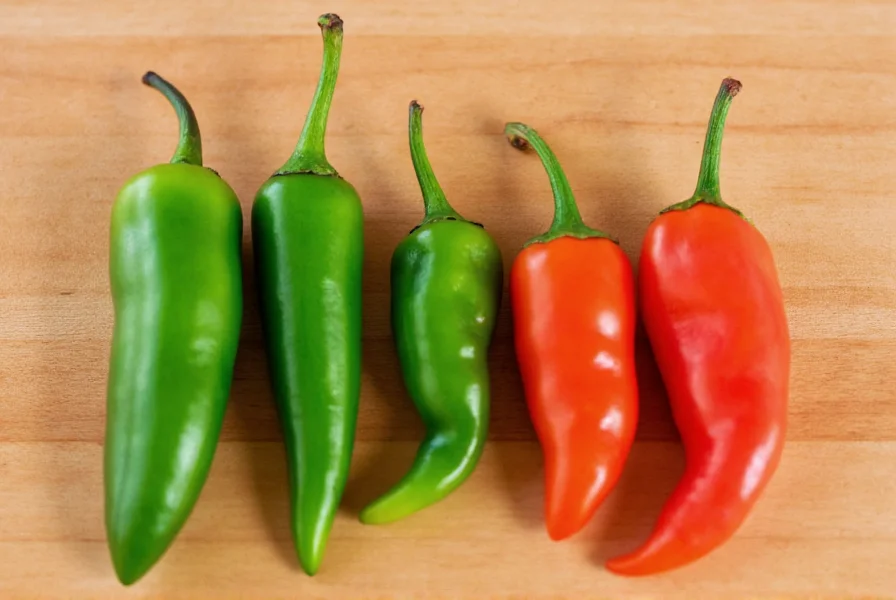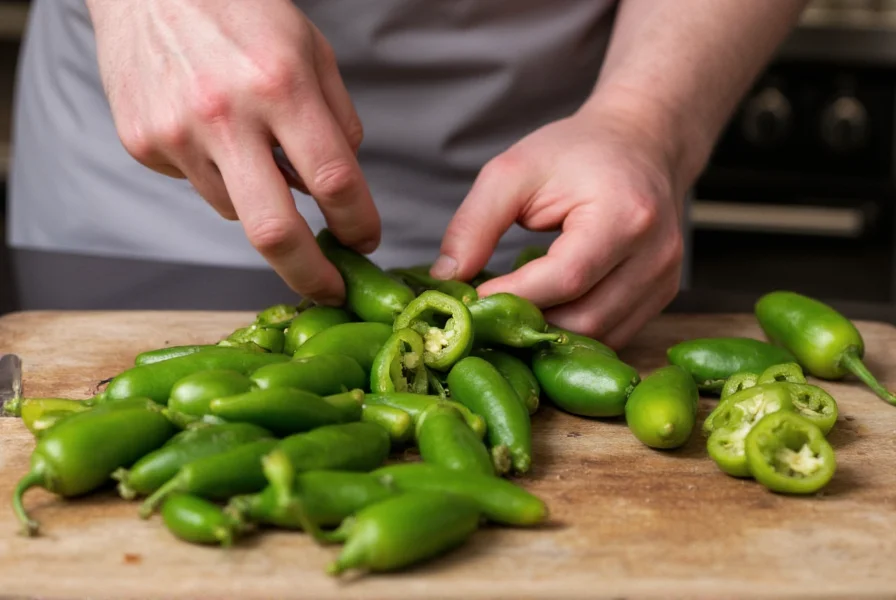If you're preparing a Mexican dish and realize you're out of serrano chile peppers, don't panic. These vibrant green peppers bring distinctive heat and flavor to salsas, guacamole, and marinades, but several excellent substitutes can save your recipe without compromising authenticity. Understanding the unique characteristics of serrano peppers is key to selecting the right replacement.
Understanding Serrano Chile Peppers
Serrano peppers rank between 10,000-23,000 on the Scoville scale, making them significantly hotter than jalapeños (2,500-8,000 SHU) but milder than habaneros (100,000-350,000 SHU). Their thin walls and crisp texture make them ideal for fresh applications, while their grassy, slightly floral notes distinguish them from other chiles. When seeking a serrano chile pepper substitute, consider both heat level and flavor profile to maintain your dish's integrity.
Top Serrano Chile Pepper Substitutes Compared
| Pepper Substitute | Scoville Heat Units | Flavor Profile | Best For | Substitution Ratio |
|---|---|---|---|---|
| Jalapeño | 2,500-8,000 | Grassy, bright, less complex | Salsas, guacamole, fresh applications | 1:1 (use 1 jalapeño per serrano) |
| Habanero | 100,000-350,000 | Fruity, floral, intense heat | Hot sauces, stews, cooked dishes | 1 serrano = ½ habanero (minced) |
| Cayenne | 30,000-50,000 | Sharp, pungent, earthy | Dried applications, powders, cooked dishes | 1 serrano = ½ tsp cayenne powder |
| Poblano | 1,000-2,000 | Earthy, mild, slightly sweet | Stuffed peppers, mild salsas, roasted applications | 1 serrano = 2 poblanos |
| Thai Bird's Eye | 50,000-100,000 | Sharp, citrusy, intense heat | Asian-Mexican fusion, hot sauces | 1 serrano = 1-2 Thai chiles |
Fresh vs. Dried Serrano Pepper Substitutes
When substituting for fresh serranos, focus on texture and moisture content. Jalapeños provide the closest fresh alternative with similar water content and crispness. For dried serrano applications (like in some mole sauces), consider these options:
- Crushed red pepper flakes: Use at 1:½ ratio (½ tsp flakes per 1 dried serrano)
- Cayenne powder: Provides similar heat profile at 1:⅓ ratio
- Guajillo powder: For milder applications requiring depth of flavor
- Chipotle powder: When smokiness complements your recipe

Recipe-Specific Substitution Guidance
The ideal serrano chile pepper substitute varies by dish. Consider these recommendations for common applications:
For Salsas and Fresh Applications
When making pico de gallo or fresh salsa verde, jalapeños remain the top choice for serrano substitution. Remove seeds and membranes from both peppers to control heat. For authentic flavor in serrano pepper substitute for salsa, add a squeeze of lime to compensate for serrano's natural brightness. If you need a mild serrano pepper alternative for family-friendly salsas, Anaheim peppers work well but require longer marinating to develop flavor.
For Cooked Dishes and Stews
In mole, chili con carne, or braised dishes, the heat differences between peppers mellow during cooking. For these applications, a combination of jalapeño and a pinch of cayenne recreates serrano's complex heat profile. When substituting in slow-cooked recipes, add hotter alternatives like habanero early in the cooking process to allow flavors to meld.
For Stuffed Peppers
For serrano pepper substitute for stuffed peppers, poblano peppers are ideal due to their thick walls and mild heat. If you prefer more heat, use jalapeños but be aware they'll shrink more during baking. Bell peppers make acceptable substitutes when heat isn't essential to the dish.
Regional Availability Considerations
Depending on your location, certain substitutes may be more accessible. In Europe, where serranos are less common, cayenne or jalapeños typically work best. In Asian markets, Thai bird's eye chilies often provide a suitable alternative, though they deliver more intense heat. For those seeking authentic Mexican recipe pepper substitutions, visit Latin American grocery stores for fresh jalapeños or dried guajillo peppers.
Common Substitution Mistakes to Avoid
Many home cooks make these errors when seeking a serrano chile pepper substitute:
- Ignoring seed content: Always adjust based on whether you're using seeded or unseeded peppers
- Misjudging heat progression: Serranos deliver immediate heat, while some substitutes like habaneros build slowly
- Overlooking flavor notes: Serranos have grassy notes that jalapeños lack—compensate with fresh herbs
- Incorrect ratios for dried applications: Dried pepper substitutions require significant quantity reduction

Storage Tips for Substitute Peppers
Maximize freshness of your serrano alternatives by storing jalapeños in perforated plastic bags in the refrigerator crisper drawer (up to 3 weeks). Freeze whole peppers for up to 6 months—frozen jalapeños work well in cooked dishes though texture changes. Dried substitutes like cayenne powder maintain potency for 6-12 months when stored in airtight containers away from light.
Final Recommendations
When selecting a serrano chile pepper substitute, prioritize matching both heat level and flavor profile to your specific recipe. For most fresh applications, jalapeños provide the closest match with minor adjustments. Remember that serrano pepper heat level comparison is crucial—never substitute hotter peppers 1:1 without reducing quantity. The best cooks treat pepper substitutions as opportunities to develop their own signature flavors while maintaining the spirit of the original recipe.











 浙公网安备
33010002000092号
浙公网安备
33010002000092号 浙B2-20120091-4
浙B2-20120091-4